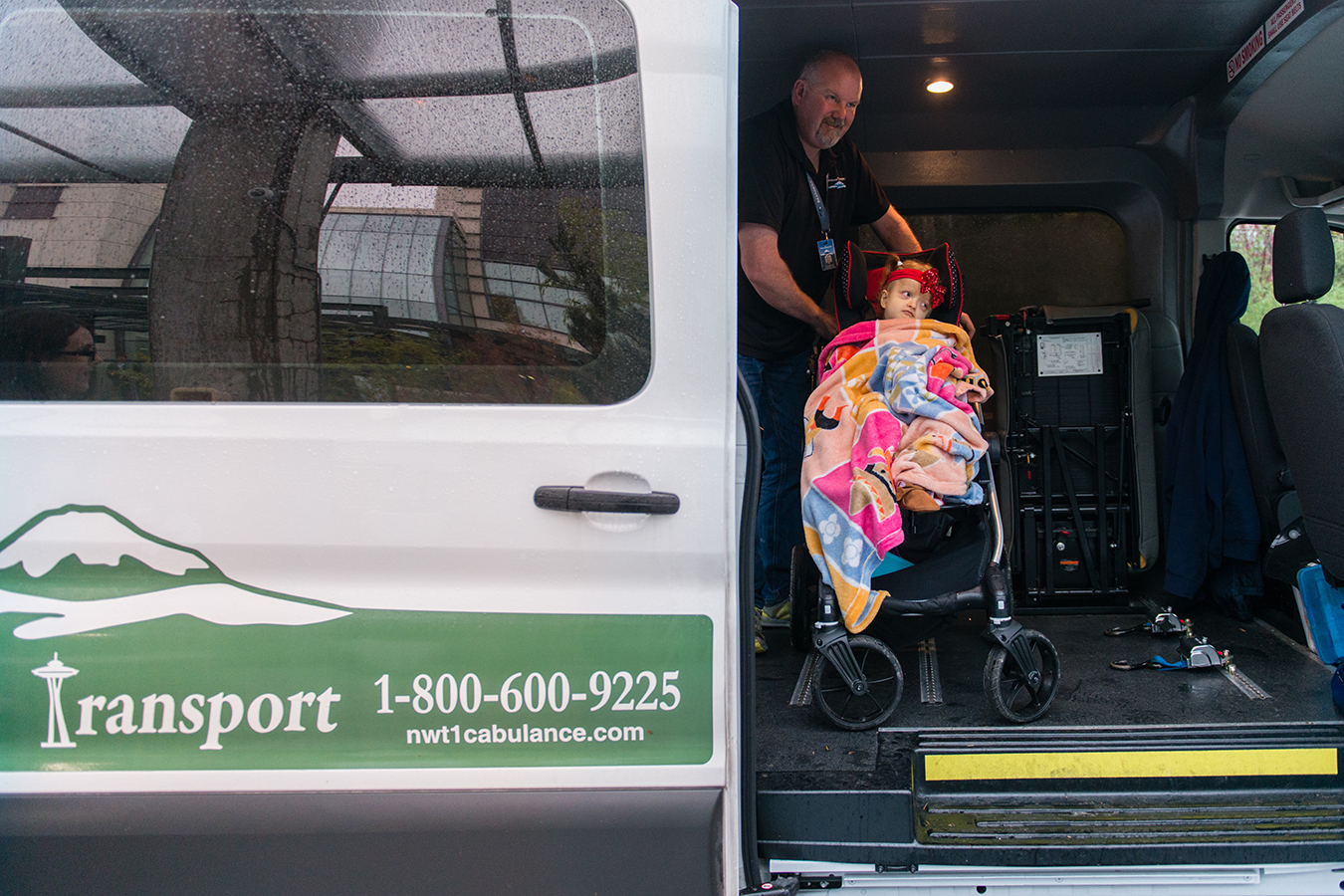Driver Donavan Dunn unloads Maddie Holt after driving her to Seattle Children’s Hospital on Nov. 21, 2017. (Heidi de Marco/KHN)
EVERETT, Wash. — Unable to walk or talk, barely able to see or hear, 5-year-old Maddie Holt waits in her wheelchair for a ride to the hospital.
The 27-pound girl is dressed in polka-dot pants and a flowered shirt for the trip, plus a red headband with a sparkly bow, two wispy blond ponytails poking out on top.
Her parents can’t drive her. They both have disabling vision problems; and, besides, they can’t afford a car. When Maddie was born in 2012 with the rare and usually fatal genetic condition called Zellweger syndrome, Meagan and Brandon Holt, then in their early 20s, were plunged into a world of overwhelming need — and profound poverty.
“We lost everything when Maddie got sick,” said Meagan Holt, now 27.
Multiple times each month, Maddie sees a team of specialists at Seattle Children’s Hospital who treat her for the condition that has left her nearly blind and deaf, with frequent seizures and life-threatening liver problems.
The only way Maddie can make the trip, more than an hour each way, is through a service provided by Medicaid, the nation’s health insurance program started more than 50 years ago as a safety net for the poor.
Called non-emergency medical transportation, or NEMT, the benefit is as old as Medicaid itself. From its inception, in 1966, Medicaid has been required to transport people to and from such medical services as mental health counseling sessions, substance abuse treatment, dialysis, physical therapy, adult day care and, in Maddie’s case, visits to specialists.
“This is so important,” said Holt. “Now that she’s older and more disabled, it’s crucial.”
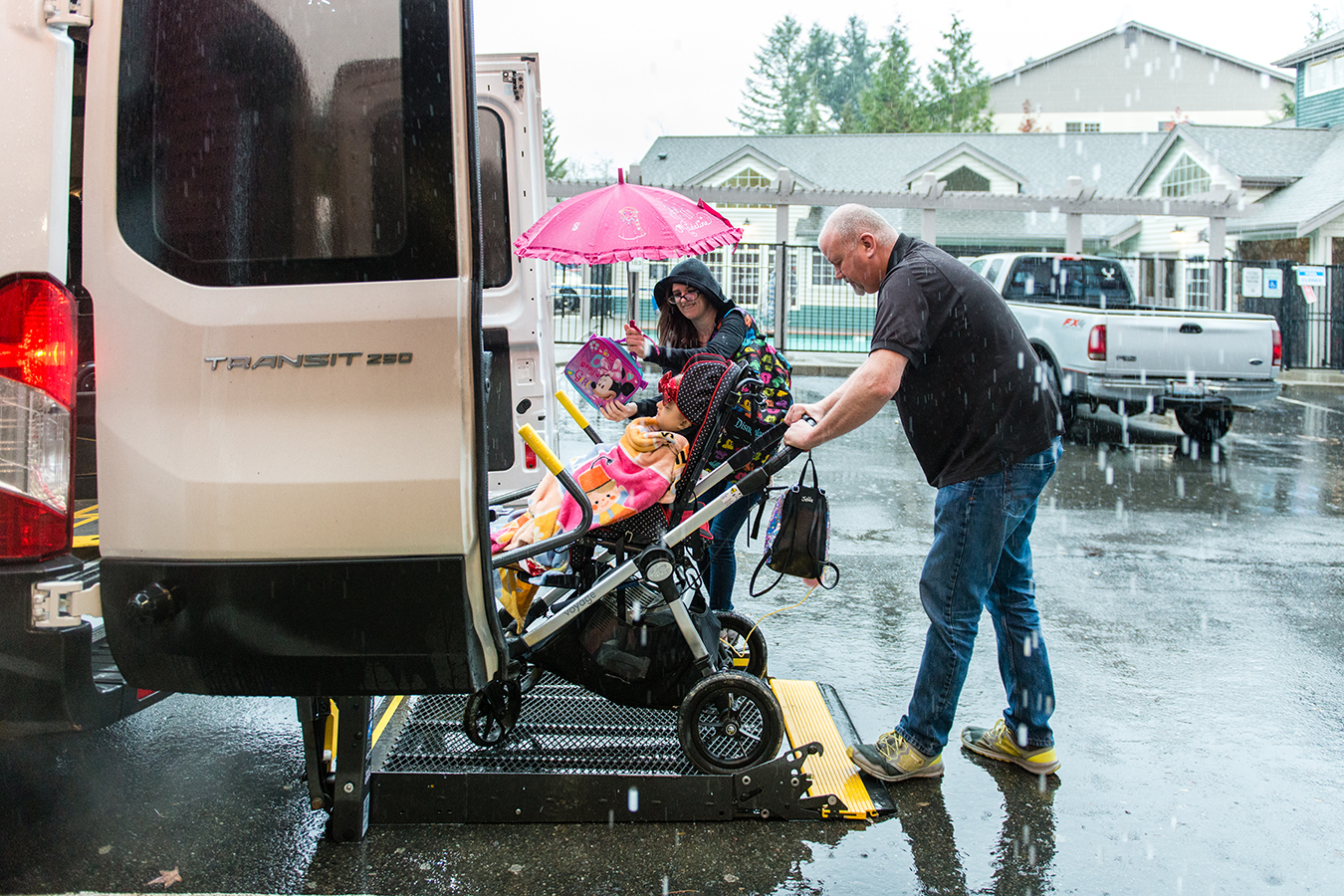
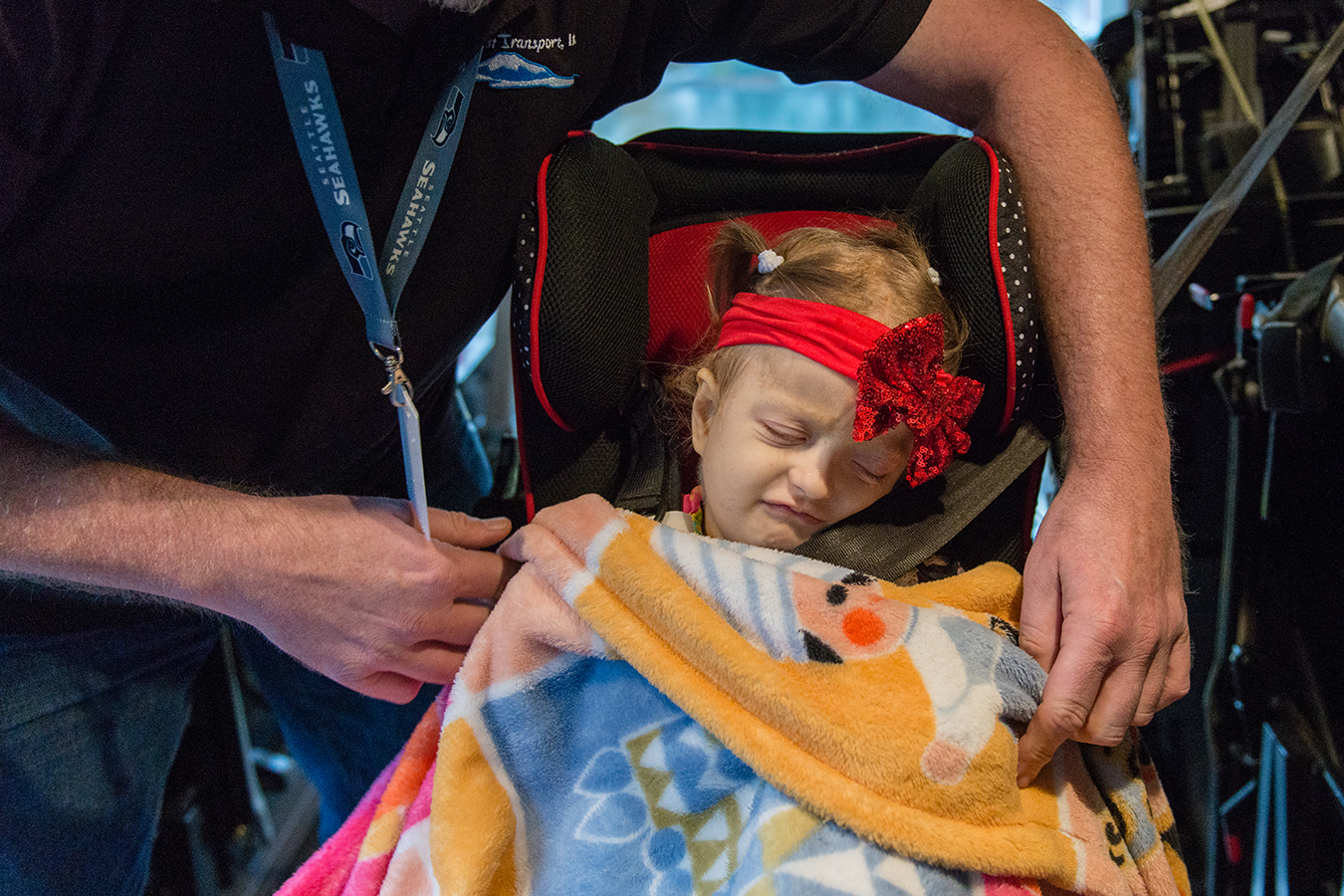

More than 1 in 5 Americans — about 74 million people — now rely on Medicaid to pay for their health care. The numbers have grown dramatically since the program expanded in 32 states plus the District of Columbia to cover prescription drugs, health screening for children, breast and cervical cancer treatment and nursing home care.
With a Republican administration vowing to trim Medicaid, Kaiser Health News is examining how the U.S. has evolved into a “Medicaid Nation,” where millions of Americans rely on the program, directly and indirectly, often unknowingly.
Medicaid’s role in transportation is a telling example. Included in the NEMT coverage are nearly 104 million trips each year at a cost of nearly $3 billion, according to a 2013 estimate, the most recent, by Texas researchers.
Citing runaway costs and a focus on patients taking responsibility for their health, Republicans have vowed to roll back the benefits, cut federal funding and give states more power to eliminate services they consider unaffordable.
Already, states have wide leeway in how to provide and pay for the transportation.
Proponents of limiting NEMT say the strategy will cut escalating costs and more closely mirror private insurance benefits, which typically don’t include transportation.
They also contend that changes will help curb what government investigators in 2016 warned is “a high risk for fraud and abuse” in the program. In recent years, the Centers for Medicare & Medicaid Services (CMS) reported that a Massachusetts NEMT provider was jailed and fined more than $475,000 for billing for rides attributed to dead people. Two ambulance programs in Connecticut paid almost $600,000 to settle claims that they provided transportation for dialysis patients who didn’t have medical needs for ambulance transportation. And the mother of a Medicaid patient who was authorized to transport her child for treatment billed Medicaid for trips that didn’t take place. She was sentenced to 30 days in jail and ordered to pay $21,500.
Last March, Rep. Susan Brooks, an Indiana Republican, introduced a resolution that would have revoked the federal requirement to provide NEMT in an effort to provide states with “flexibility.” That effort stalled.
Another Republican proposal in 2017 would have reversed the Affordable Care Act’s Medicaid expansion and reduced federal funding for the NEMT program. It failed, but other efforts by individual states still stand.
Former Health and Human Services Secretary Tom Price and CMS Administrator Seema Verma encouraged the nation’s governors to consider NEMT waivers, among other actions, in a March letter to them.
“We wish to empower all states to advance the next wave of innovative solutions to Medicaid challenges,” they wrote. The Trump administration has used state waivers to bypass or unravel a number of the Obama administration’s more expansive health policies, and has granted some states’ requests.
At least three states, Iowa, Indiana and Kentucky, have received federal waivers — and extensions —allowing them to cut Medicaid transportation services. Massachusetts has a waiver pending.
Critics of the cuts worry the trend will accelerate, leaving poor and sick patients with no way to get to medical appointments.
“I wouldn’t be surprised to see more of these waivers in the pipeline,” said Joan Alker, executive director of the Georgetown University Center for Children and Families.
Because medical transportation isn’t typically covered by the commercial insurance plans most Americans use, it’s unfamiliar to many people and could be seen as unnecessary, said Eliot Fishman, senior director of health policy for Families USA, a nonprofit, nonpartisan consumer health advocacy group.
Formerly a Medicaid official in the federal government, Fishman called the transportation program “vital” not only for children with severe disabilities, but also for non-elderly, low-income adults.
CMS released results of a 2014 survey of Medicaid users, which found that lack of transportation was the third-greatest barrier to care for adults with disabilities, with 12.2 percent of those patients reporting they couldn’t get a ride to a doctor’s office.
“This is not something to be trifled with lightly,” Fishman said. “We’re talking about a lifesaving aspect of the Medicaid program.”
About 3.6 million Americans miss or delay non-emergency medical care each year because of transportation problems, according to a 2005 study published by the National Academy of Sciences.
That same study analyzed costs for providing NEMT to patients facing 12 common medical conditions and found that providing additional transportation is cost-effective. For four of those conditions — prenatal care, asthma, heart disease and diabetes — medical transportation saved money when the total costs for both transportation and health care were tallied.
Medicaid is required to provide NEMT services using the most appropriate and least costly form of transportation, whether that’s taxis, vans or public transit.
Most states rely on NEMT brokers or managed-care organizations to administer the transportation services. Other states run the service directly, paying providers on a per-ride basis, while some use local ride services and pay independent taxi firms to shuttle patients.
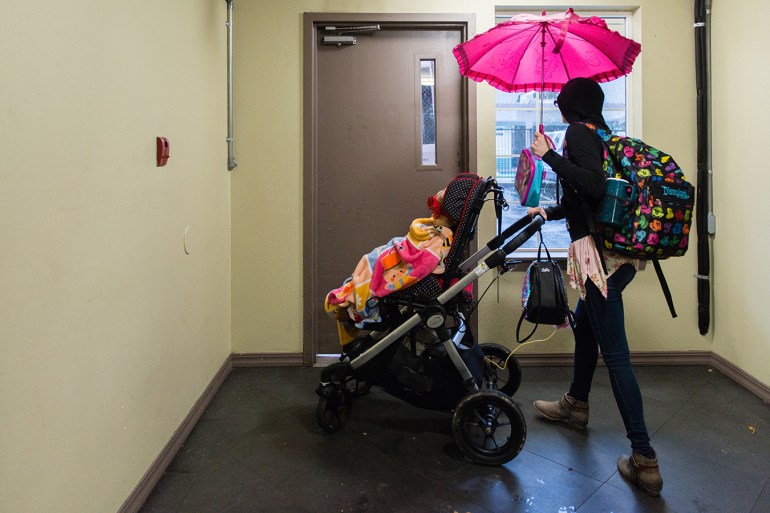
Meagan Holt wheels daughter Maddie outside for a ride to Seattle Children’s Hospital on Nov. 21, 2017. Holt doesn’t drive due to serious vision problems and can’t afford a car. (Heidi de Marco/KHN)
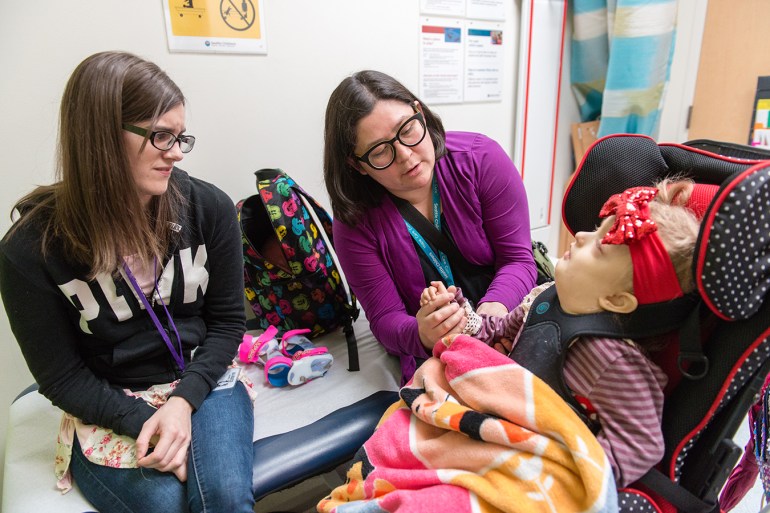
Dr. Molly Fuentes examines the mobility of Maddie Holt’s arms on Nov. 21, 2017. (Heidi de Marco/KHN)
Proponents of revamping NEMT note that disabled children like Maddie and other people with serious disabilities are in little danger of losing services. In Iowa and Indiana, Medicaid transportation remains available to several groups of patients, including those classified as “medically frail,” though the definition of who qualifies can vary widely.
In addition, one managed-care provider, Anthem, continues to transport Indiana Medicaid patients, despite the waiver that was first enacted in 2007.
Still, Medicaid clients like Fallon Kunz, 29, of Mishawaka, Ind., are often stuck. Kunz, who has cerebral palsy, migraine headaches and chronic pain, uses a power wheelchair. When she was a child, she qualified for door-to-door service to medical appointments, she said.
Today, she lives with her father, whose home is outside the route of a Medicaid transit van. Getting to and from medical appointments for her chronic condition is a constant struggle, she said. Taxis are too expensive: $35 each way for a wheelchair-enabled cab.
“The only way I can get rides to and from my doctor’s appointment is to ride the 2 miles in my wheelchair, despite all kinds of weather, from my home, across the bridge, to the grocery store,” she said. “Right outside the grocery store is the bus stop. I can catch the regular bus there.”
Sometimes, she’s in too much pain or the Indiana weather — warm and humid in the summer, frigid and windy in the winter — is too much to battle and she skips the appointment.
“Today I didn’t go because it was too cold and my legs hurt too much,” she said on a December Tuesday. “I didn’t feel like getting blown off the sidewalk.”
In Maddie Holt’s case, she was shuttled to Seattle Children’s on a rainy Tuesday morning in a medical van driven by Donavan Dunn, a 47-year-old former big-rig trucker. He works for Northwest Transport, one of several regional brokers that manage NEMT services for Washington state.
Dunn said he received special training to transport patients like Maddie, who is loaded onto a motorized platform, wheelchair and all, into the van and then carefully strapped in.
“I have to drive different,” said Dunn. “I have to watch my corners, watch my starts, watch my stops. It’s always in the back of my mind that I have somebody on board that’s fragile.”
We’re talking about a lifesaving aspect of the Medicaid program.

Dr. Molly Fuentes examines the mobility of Maddie Holt’s arms. (Heidi de Marco/KHN)
The transportation service can be used only for medical visits to the specialists who treat Maddie’s condition, which is caused by mutations in any one of at least 12 genes. If Meagan Holt needs to pick up prescriptions or get groceries, she leaves Maddie and a second daughter, Olivia, 3, at home with their dad and takes the bus or walks to her destinations.
Caring for a severely disabled child is not the life she expected, Meagan Holt said, but she cherishes time with Maddie, who has learned to communicate through tactile sign language spelled into her hand.
“She knows about 100 words. She knows the alphabet,” Meagan said. “She likes Disney princesses. She loves ‘Frozen.’”
Maddie is one of hundreds of NEMT-eligible children transported to Seattle Children’s each month. Last September, for instance, more than 1,300 clients made more than 3,600 trips at a cost of more than $203,000, according to the Washington Health Care Authority, which oversees the state’s Medicaid program called Apple Health.
The need is so great, in fact, that the hospital created a transportation will-call desk to help organize the comings and goings.
“When we realized how much transportation is a barrier to getting to your appointment, we decided to do something about it,” said Julie Povick, manager of international exchanges and guest services at Seattle Children’s.
“The majority of our patients are in survival mode,” Povick added. “You need a lot of handholding.”
But Verma, the architect of Indiana’s Medicaid overhaul plan, has suggested that too much handholding might be “counterproductive” for patients — and bad for the country.
In a 2016 Health Affairs essay, Verma noted that early analysis of the effects of curtailing NEMT in Indiana showed that more Medicaid patients with access to the program said transportation was a primary reason for missed appointments than did members without access.
“Moreover, 90 percent of [Healthy Indiana Plan] members report having their own transportation or the ability to rely on family and friends for transportation to health care appointments,” she wrote.
But Marsha Simon, a Washington, D.C., health policy consultant who has tracked NEMT for years, said Medicaid is the option of last resort. People who are able to get rides on their own already do.
“If 90 percent can and 10 percent can’t, what about the 10 percent?” Simon said.
It’s a question that haunts Kunz every day.
“I’m a college student, I have a cat,” said Kunz, who is studying psychology online at Southern New Hampshire University. “I’m just a regular human trying to do things, and the inaccessibility in this area is ridiculous.”
KFF Health News' coverage of these topics is supported by Gordon and Betty Moore Foundation, Heising-Simons Foundation, The SCAN Foundation and John A. Hartford Foundation



